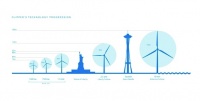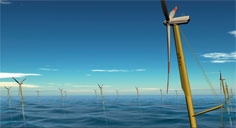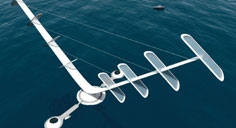
Clipper Wind is one of two companies developing 10MW units. The other is Norwegian firm Sway, based in Bergen, which has won a NKr137m (£14.5m) award from Enova, a Norwegian government body dedicated to funding and promoting renewable energy technologies. Both companies are at the design stage, but hope to have full-sized prototypes ready to deploy within the next two years.
However, the two projects are taking very different tacks. Clipper Wind, working from a base in Blyth, Northumberland, is looking at a conventionally styled wind turbine, 145m in diameter, with a solid foundation on the seabed, whose rotors face the wind head-on. Sway, however, is developing floating wind turbines, anchored by a single flexible tether, which have their backs to the wind (see ’Ocean current’, The Engineer, 28 June 2008). Moreover, while the Clipper Wind version will have a geared wind turbine, Sway is developing a gearless direct-drive generator, using technology similar to that currently being developed by both Siemens and GE.

Clipper chose the UK as the base for its project because of its proximity to the large European market for wind power and is sinking $65m (£44m) into building facilities, including a blade factory in Newcastle, and will use a new offshore turbine testing facility at the National Renewable Energy Technology Centre (NaREC) in Blyth. Dubbed Project Britannia, the project is also receiving £5m from the local Regional Development Agency, One NorthEast.
’The current offshore market is in Europe, for installations in the North Sea and the Baltic,’ said Grainger. ’It’s starting to look like there might be a market in the US - the first permission for offshore wind was granted there a few months ago - but we started this project four years ago, in the middle of the Bush administration, when there was absolutely no chance of offshore wind.’
Investment boom sees UK’s return to power in offshore-wind market
Britain, it’s generally accepted, lost its wind-energy industry in the 1980s, losing out to Germany and Denmark. This situation seemed set to continue with the closure of Vestas’s blade factory on the Isle of Wight last year. However, recent months have seen a resurgence of interest in wind-technology manufacturing in the UK.
Shortly after Clipper Wind announced its investments in the North East, Siemens and Mitsubishi declared that they would also build wind-turbine manufacturing capacity in the UK, spurred by the former government’s announcement of £60m funding for land development in its last budget and the news in January of the Crown Estate’s Round Three offshore-wind licensing programme. This is planned to deliver up to 32GW of renewable energy in British waters by 2020, making the UK one of the biggest offshore wind markets in the world.
Feargal Brennan’s NOVA project represents another attempt to revive the industry, but this time through IP, as well as inward investment.
Government spending is up for review and technology development is inherently risky, but it seems as though a sector that a year ago looked as if it would only benefit overseas companies and employment could be returning to health.
The developing market is also one of the reasons Clipper is developing a conventional geared system. ’We’re looking for where the market is going to be in five years’ time and that’s what we think will dominate in the North Sea and Baltic markets,’ Grainger said.
The generator is likely to be a close-coupled unit, he added. ’If you look at the 5MW turbines out there at the moment, there’s the Areva Multibrid, which has a single-stage gearbox, and the REPower, which has a multistage gearbox - a typical Danish design with a long shaft supported by big bearings, the gearbox hanging off that, a coupling and a generator. We’re going to be closer to the more integrated design, like the Multibrid; we believe it’s the way to keep the weight down. We can’t just scale up what we have because that will increase the weight in a more than linear relationship; weight feeds into everything, including installation and foundations.’
Clipper hopes to develop a generator that will weigh around 400-500 tonnes, similar to that of a 5MW REPower turbine. ’Then you could use the same installation vessel and that’s one of the major cost reductions. If you can install using the same vessel in the same time as a 5MW system, then obviously you’re going to save money.’
The gearless system adopted by Sway is another method of reducing weight. At Øygarden in Norway, Sway is working with Smartmotor, another Norse company, to develop the direct-drive generators, which have fewer moving parts than a geared system. Smartmotor has already developed ’rim-machines’; direct-drive electrical systems that can be used both as motors and generators. One example of this is a tunnel thruster developed with Rolls-Royce.

The Sway system uses a ballast-loaded mast floating in the ocean, which is anchored to the seabed by a flexible stay that allows the tower to swivel. The mast is supported by cables similar to those used on the mast of a sailing ship and these, along with the flexible anchor, are claimed to reduce stresses in the structure. The mast can therefore carry a larger turbine than would be possible on a conventional tower of the same height. ’We regard this specific project as very exciting. It represents a considerable ramping-up of current technology, in which diverse Norwegian expert communities have cooperated to develop a totally new wind-turbine design,’ said Nils Kristian Nakstad, executive director of Enova.
However, both companies are going to face a problem that is inherent to horizontal-axis wind turbines - fatigue. ’Upsizing to 10MW using that conventional horizontal-axis configuration has significant challenges - not least the weight of the blades, which experience a fully reversed fatigue cycle on each rotation,’ explained Feargal Brennan, head of offshore, process and energy engineering at Cranfield University. As the blades turn, their weight always pulls downwards, putting a changing stress on the structure, in a cycle that repeats with every rotation. ’This is a self-limiting situation,’ Brennan added. ’In order to reduce the fatigue stress, the blade sections and thicknesses are increased. This then further increases the blade self-weight.’
These issues continue throughout the device. Drive-train mountings must be stiff enough to support the heavier components inside the nacelle on top of the tower, otherwise the systems can become misaligned, Brennan said. ’The support structure is also exposed to extremely large dynamic thrust and bending stresses, which are amplified significantly with any increase in water depth.’
Brennan is currently working on a large-scale vertical-axis wind-turbine design, called NOVA, which he believes might be better suited to 10MW systems (see ’Vertical axis turbine puts new spin on wind energy’, The Engineer, 22 February 2010). ’In comparison, it doesn’t have the same weight constraints and because the blades rotate around the vertical rather than the horizontal axis, they do not suffer weight-induced fatigue,’ he said. A 10MW vertical-axis system would be about half the height of a horizontal-axis turbine, however.
There isn’t a technical issue that screams out size limit. They’ll get bigger than 10MW
Bill Grainger, Clipper Wind Marine

Grainger agrees that fatigue must be addressed, but doesn’t believe it will be a problem. ’It’s a very serious matter, but it’s not a problem per se. Wind turbines are fatigue-driven structures, there’s no getting away from that. We’re using the latest modelling to look at the fatigue in the design and get it down to acceptable limits.’
Wind turbines shake and vibrate, and the degree to which they do this varies, he said. ’With variable-speed loading, you’re running through a range of frequencies so you have to be very careful; you need to look at all the modes you can excite. It’s a large structure and there’s a lot of power involved; it’s the dominant feature and the main driver behind the design.’
Maintenance is also an important issue. ’Getting onto the structure won’t be straightforward. They’ll be further from port than current wind turbines and the seas will be rougher,’ Grainger said. ’We’re putting a lot of emphasis on making the things reliable and adding features such a big crane inside the maintenance cell and guidance so the large components can be handled and moved around.’
So is 10MW the limit for turbines? Grainger doesn’t think so. ’There isn’t a technical issue that screams out size limit,’ he said. ’You have to make changes as you get bigger. Blades get floppier, for example, so you have to put more carbon in; but we aren’t anywhere near 100 per cent carbon yet. There might be a limit to the size that people want to put into the field; if a 20MW turbine failed, that’s a big chunk of electricity to lose. But then if a power station goes offline you’ve lost 300MW, so I don’t think that’s a limit either. They’ll get bigger than 10MW, is my feeling. How much bigger? I don’t know.’
From the archive
In 1894 The Engineer went to see a wind turbine in West London
We recently had the opportunity to examine a new type of wind motor built by Rollason’s Wind Motor Company of Berners Street, London.
The portion that receives rotary motion from the pressure of the wind consists of five wooden vanes, each vane forming a segment of a tube of very large diameter and fixed so that it presents its concave surface to the direction of the wind. These vanes are fixed top and bottom to a five-armed star that is keyed to a vertical shaft. Each vane is 20ft high and the chord of arc of section is 7ft long, while the measurement from the inner vane to the centre of the axis is 7ft.
The dynamo is by the Electric Construction Corporation and develops 65V and 35A when running at 510rev/min. The whole apparatus is theoretically perfect, but we are afraid that the delicacy of the parts will lead to trouble. It must be remembered that, for such a motor and plant to be of use, it must be simple enough to be attended to by a gardener.





Collaboration to address viable solutions for VAWG database
Interesting to see what the funders say too..."The Innovation Launchpad Network+, .... brings together leading universities, the Catapult Network and...